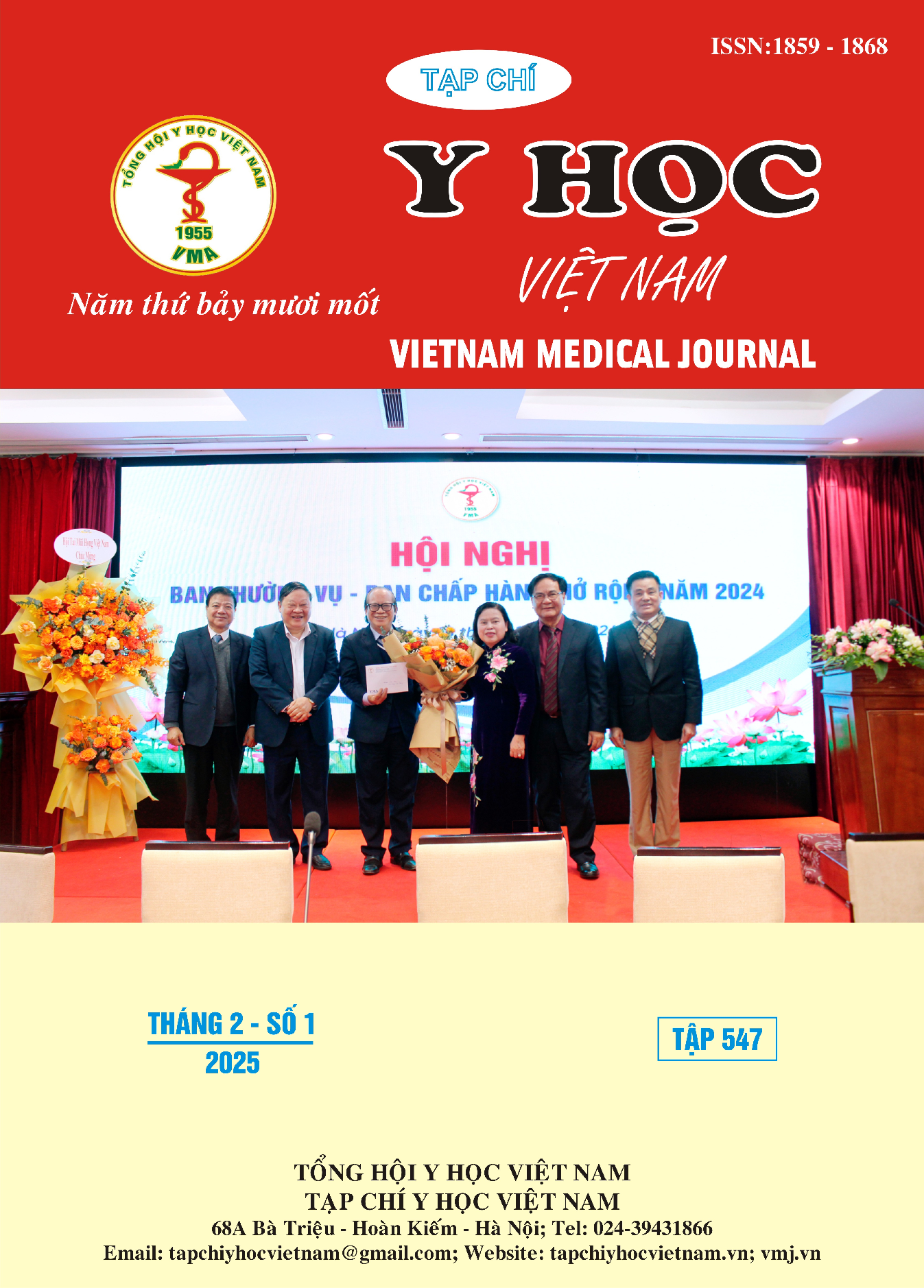CLINICAL CHARACTERISTICS AND DERMOSCOPIC IMAGES OF PATIENTS WITH ANDROGENETIC ALOPECIA
Main Article Content
Abstract
Objective: To describe the clinical characteristics and dermoscopic images of patients with androgenetic alopecia. Material and methods: Cross-sectional descriptive study. Results: 200 patients with androgenetic alopecia (106 males, 94 females) visited the National Hospital of Dermatology and Venereology from November 2023 to September 2024, with an average age of 25.47 ± 5.58 years, and an average duration of hair loss of 53.78 ± 30.29 weeks. The severity of the disease in males, according to the Hamilton classification, was predominantly at grade 2 (61.3%) and grade 3 (25.5%). In female patients, the severity of the disease, based on the Ludwig classification, was primarily grade 1 (63.8%). The average hair diameter and the number of hairs per follicle in the occipital region were higher than in the other three regions, but still lower than in healthy individuals. The most commonly observed dermoscopic feature was hair diameter variability, followed by the peripilar sign. The feature of a honeycomb pigment pattern was not observed in any of the four regions. The hair diameter variability and peripilar sign were associated with disease severity in the forehead area for men and the vertex area for women. Conclusion: In younger patients with androgenetic alopecia, the disease severity was generally milder. Dermoscopic features such as hair diameter variability and the peripilar sign were related to the severity of the disease in certain areas like the vertex, temples, and forehead.
Article Details
Keywords
androgenetic alopecia, dermoscopy, clinical characteristics.
References
2. Androgenetic alopecia in males: Pathogenesis, clinical features, and diagnosis - UpToDate. Accessed June 20, 2023.
3. https://www.uptodate.com/contents/androgenetic-alopecia-in-males-pathogenesis-clinical-features-and-diagnosis#H21714534
4. Kenneth A. Arndt. Manual of Dermatologic Therapeutics. 8th ed. Lippincott Williams and Wilkins; 2015.
5. Paik JH, Yoon JB, Sim WY, Kim BS, Kim NI. The prevalence and types of androgenetic alopecia in Korean men and women. Br J Dermatol. 2001;145(1): 95-99. doi:10.1046/j. 1365-2133.2001.04289.x
6. Kasumagic-Halilovic E. Trichoscopic Findings in Androgenetic Alopecia. Med Arch. 2021 Apr;75(2): 109-111. doi: 10.5455/medarh. 2021.75.109-111. PMID: 34219869; PMCID: PMC8228579.
7. Kibar M, Aktan S, Bilgin M. Scalp dermatoscopic findings in androgenetic alopecia and their relations with disease severity. Ann Dermatol. 2014 Aug;26(4):478-84. doi: 10.5021/ ad.2014.26.4.478. Epub 2014 Jul 31. PMID: 25143677; PMCID: PMC4135103.
8. Inui S, Nakajima T, Itami S. Scalp dermoscopy of androgenetic alopecia in Asian people. J Dermatol. 2009 Feb;36(2):82-5. doi: 10.1111/ j.1346-8138.2009.00593.x. PMID: 19284450. Salman KE, Altunay IK, Kucukunal NA, Cerman AA. Frequency, severity and related factors of androgenetic alopecia in dermatology outpatient clinic: hospital-based cross-sectional study in Turkey. An Bras Dermatol. 2017 Jan-Feb;92(1): 35-40. doi: 10.1590/abd1806-4841.20175241. PMID: 28225954; PMCID: PMC5312176.
9. Kim BJ, Kim JY, Eun HC, Kwon OS, Kim MN, Ro BI. Androgenetic alopecia in adolescents: a report of 43 cases. J Dermatol. 2006 Oct;33(10): 696-9. doi: 10.1111/j.1346-8138.2006.00161.x. PMID: 17040499.
10. Salman KE, Altunay IK, Kucukunal NA, Cerman AA. Frequency, severity and related factors of androgenetic alopecia in dermatology outpatient clinic: hospital-based cross-sectional study in Turkey. An Bras Dermatol. 2017 Jan-Feb;92(1): 35-40. doi: 10.1590/abd1806-4841. 20175241. PMID: 28225954; PMCID: PMC5312176.


